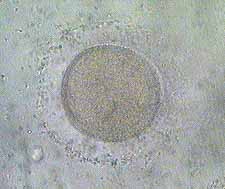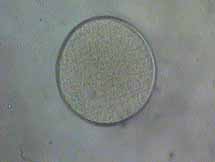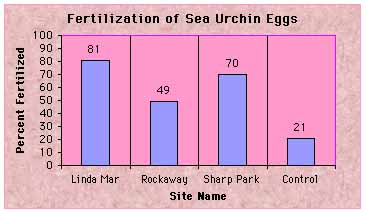|
|
|
|
Figure 1. Fertilized sea urchin egg. Notice complete fertilization membrane. |
Figure 2. Unfertilized sea urchin egg. Notice there is no fertilization membrane. |
The rate of sea urchin fertilization was used as an indicator of water quality for water collected at three beaches in Pacifica, California. Water was collected from Linda Mar State Beach, Rockaway Beach and Sharp Park Beach and stored at 12°C. Sea urchin eggs and sperm were exposed to the collected water samples and a control of Instant Ocean sea water for a time period of 20 minutes. Five drops of exposed sperm were then added to the exposed egg solutions and the solutions were left to fertilize for a time period of 20 minutes. Five drops of 3% Formaldehyde were introduced at the end of the designated time period to end the experiment. Out of each sample, 100 eggs were counted and the percent of fertilized eggs was calculated. A fertilized egg was defined as having a complete fertilization membrane (figure 1). A damaged, absent, or incomplete fertilization membrane was counted as an unfertilized egg (figure 2).
Figure 1. Fertilized sea urchin egg.
Notice complete fertilization membrane. Figure 2. Unfertilized sea urchin egg.
Notice there is no fertilization membrane.


Results from this study (figure 3) were inconclusive. Their was surprisingly a very low fertilization rate of the control sea water. These results were inconsistent with the great success rate achieved during laboratory courses.

Figure 3. Results of sea urchin fertilization test.